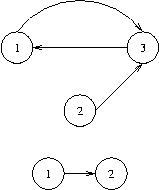The Bottom of a Graph
| Time Limit: 3000MS | Memory Limit: 65536K | |
| Total Submissions: 11044 | Accepted: 4542 |
Description
Let n be a positive integer, and let p=(e1,...,en) be a sequence of length n of edges ei∈E such that ei=(vi,vi+1) for a sequence of vertices (v1,...,vn+1). Then p is called a path from vertex v1 to vertex vn+1 in G and we say that vn+1is reachable from v1, writing (v1→vn+1).
Here are some new definitions. A node v in a graph G=(V,E) is called a sink, if for every node w in G that is reachable from v, v is also reachable from w. The bottom of a graph is the subset of all nodes that are sinks, i.e.,bottom(G)={v∈V|∀w∈V:(v→w)⇒(w→v)}. You have to calculate the bottom of certain graphs.
Input
Output

Sample Input
3 3 1 3 2 3 3 1 2 1 1 2 0
Sample Output
1 3 2
Source
定义:点v是汇点须满足 --- 对图中任意点u,若v可以到达u则必有u到v的路径;若v不可以到达u,则u到v的路径可有可无。
#include<cstdio>
#include<cstdlib>
#include<cstring>
#include<iostream>
#include<algorithm>
#define N 10000
using namespace std;
bool vis[N];
int n,m,x,y,sum,tim,tot,top;
int out[N],dfn[N],low[N],ans[N],head[N],stack[N],belong[N],point[N];
inline int read()
{
,f=;char ch=getchar();
;ch=getchar();}
+ch-';ch=getchar();}
return f*x;
}
struct Edge
{
int from,to,next;
}edge[500010];
void add(int x,int y)
{
tot++;
edge[tot].to=y;
edge[tot].next=head[x];
head[x]=tot;
}
void begin()
{
tot=;top=;sum=,tim=;
memset(edge,,sizeof(edge));
memset(stack,,sizeof(stack));
memset(head,,sizeof(head));
memset(,sizeof(out));
memset(dfn,,sizeof(dfn));
memset(low,,sizeof(low));
memset(belong,,sizeof(belong));
memset(ans,,sizeof(ans));
}
int tarjan(int now)
{
dfn[now]=low[now]=++tim;
stack[++top]=now;vis[now]=true;
for(int i=head[now];i;i=edge[i].next)
{
int t=edge[i].to;
if(vis[t]) low[now]=min(low[now],dfn[t]);
else if(!dfn[t]) tarjan(t),low[now]=min(low[now],low[t]);
}
if(dfn[now]==low[now])
{
sum++;belong[now]=sum;
for(;stack[top]!=now;top--)
{
vis[stack[top]]=false;
belong[stack[top]]=sum;
}
vis[now]=false;top--;
}
}
void shrink_point()
{
;i<=n;i++)
for(int j=head[i];j;j=edge[j].next)
if(belong[i]!=belong[edge[j].to])
out[belong[i]]++;
}
int main()
{
while(~scanf("%d",&n)&&n)
{
m=read();begin();
;i<=m;i++)
x=read(),y=read(),add(x,y);
;i<=n;i++)
if(!dfn[i]) tarjan(i);
shrink_point();
x=;
;i<=n;i++)
if(!out[belong[i]]) ans[++x]=i;
sort(ans+,ans++x);
if(x)
{
;i<x;i++)
printf("%d ",ans[i]);
printf("%d\n",ans[x]);
}
else printf("\n");
}
;
}
注意:注意数组的大小!!
The Bottom of a Graph的更多相关文章
- The Bottom of a Graph(tarjan + 缩点)
The Bottom of a Graph Time Limit: 3000MS Memory Limit: 65536K Total Submissions: 9139 Accepted: ...
- poj 2553 The Bottom of a Graph(强连通分量+缩点)
题目地址:http://poj.org/problem?id=2553 The Bottom of a Graph Time Limit: 3000MS Memory Limit: 65536K ...
- poj 2553 The Bottom of a Graph【强连通分量求汇点个数】
The Bottom of a Graph Time Limit: 3000MS Memory Limit: 65536K Total Submissions: 9641 Accepted: ...
- POJ 2553 The Bottom of a Graph (Tarjan)
The Bottom of a Graph Time Limit: 3000MS Memory Limit: 65536K Total Submissions: 11981 Accepted: ...
- 【图论】The Bottom of a Graph
[POJ2553]The Bottom of a Graph Time Limit: 3000MS Memory Limit: 65536K Total Submissions: 11182 ...
- POJ 2553 The Bottom of a Graph(强连通分量)
POJ 2553 The Bottom of a Graph 题目链接 题意:给定一个有向图,求出度为0的强连通分量 思路:缩点搞就可以 代码: #include <cstdio> #in ...
- poj--2553--The Bottom of a Graph (scc+缩点)
The Bottom of a Graph Time Limit : 6000/3000ms (Java/Other) Memory Limit : 131072/65536K (Java/Oth ...
- POJ——T2553 The Bottom of a Graph
http://poj.org/problem?id=2553 Time Limit: 3000MS Memory Limit: 65536K Total Submissions: 10987 ...
- POJ-2552-The Bottom of a Graph 强连通分量
链接: https://vjudge.net/problem/POJ-2553 题意: We will use the following (standard) definitions from gr ...
随机推荐
- sql语句分为三类(DML,DDL,DCL)-介绍
本文知识来源自:<Oracle专家高级编程> 分享作者:Vashon 时间:20150415 DDL is Data Definition Language statements. Som ...
- Oracle ORA
ORA-00001: 违反唯一约束条件 (.) 错误说明:当在唯一索引所对应的列上键入重复值时,会触发此异常. ORA-00017: 请求会话以设置跟踪事件 ORA-00018: 超出最大会话数 OR ...
- 洛谷 P1163 银行贷款
题目描述 当一个人从银行贷款后,在一段时间内他(她)将不得不每月偿还固定的分期付款.这个问题要求计算出贷款者向银行支付的利率.假设利率按月累计. 输入输出格式 输入格式: 输入文件仅一行包含三个用空格 ...
- 洛谷 P1803 凌乱的yyy
题目背景 快noip了,yyy很紧张! 题目描述 现在各大oj上有n个比赛,每个比赛的开始.结束的时间点是知道的. yyy认为,参加越多的比赛,noip就能考的越好(假的) 所以,他想知道他最多能参加 ...
- Halcon学习笔记2
图像预处理 一般来说,我们采集到的图像会有一些小黑点,小斑点,不平滑等因素会会影响我们后期的算法,此时就需要我们对其图片进行预处理. 下面是一些预处理基本算子: 1.消除噪声:mean_image/b ...
- XtraBackUp 热备份工具
是一款强大的在线热备份工具 备份的过程中,不锁表 使用percona-xtrabackup-24-2.4.7-1.el7.x86_64.rpm yum源安装: 1.安装Percona的库: ...
- dialog - 从 shell 显示对话框
总览 (SYNOPSIS) dialog --clear dialog --create-rc file dialog --print-maxsize dialog common-options bo ...
- window Chrome 下允许跨域访问服务端接口设置
关闭chrome,使用cmd命令进入chrome安装目录cd C:\Program Files (x86)\Google\Chrome\Application 然后使用命令打开chromechrome ...
- 暑假集训 || 区间DP
区间DP 经典石子合并问题V1 复杂度 On3 int a[SZ], sum[SZ], f[SZ][SZ]; int main() { int n; scanf("%d", ...
- MySQL-02 数据表管理
学习要点 数据类型 数据字段属性 数据表的类型及存储位置 索引 数据表对象管理 数据类型 数据库中的数据类型分为字段类型和值类型,定义如下: 在设计数据表字段的时候,字段类型定义为三大类:数值类.字符 ...
